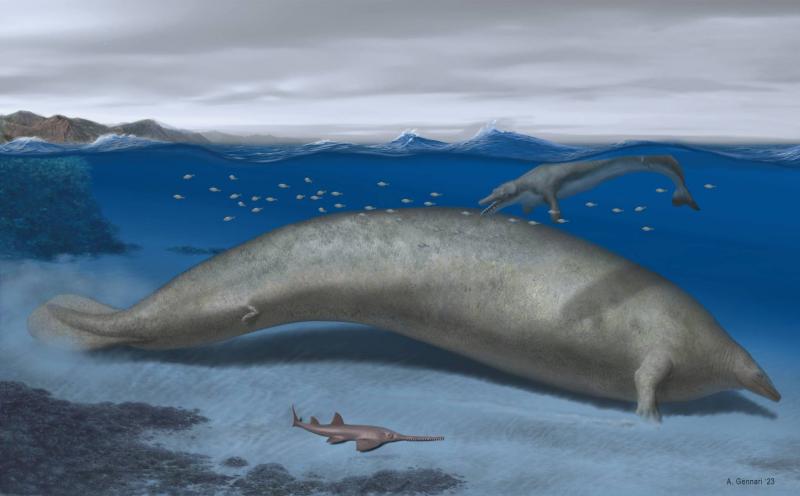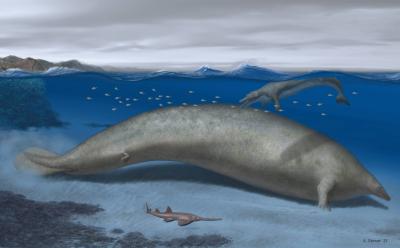Step aside, blue whale, for there is a new contender for the title of the largest animal known to earth!
On Wednesday, scientists discovered a giant whale of the species *Perucetus* during excavations in Peru, which lived around 38 to 40 million years ago during the Eocene epoch. This creature resembles a manatee in its structure and may have had a mass exceeding that of the blue whale, long considered the largest recorded animal in history. Researchers estimate that the *Perucetus* was about 20 meters long and weighed up to 340 tons, surpassing any other known animal, including the modern blue whale and the largest dinosaurs. The scientific name *Perucetus* means "the giant Peruvian whale."
Giovanni Bianucci, a paleobiologist at the University of Pisa in Italy and the main author of the research published in the journal *Nature*, stated, "The main characteristic of this animal is undoubtedly its massive weight, indicating the existence of creatures with attributes beyond our imagination."
**Larger Than Dinosaurs**
The estimated minimum size for *Perucetus* is 85 tons, with an average weight of 180 tons. The largest known blue whale weighed around 190 tons, although it was longer than *Perucetus*, measuring 33.5 meters. Studies estimate the weight of the colossal dinosaur Argentinosaurus at about 76 tons. This long-necked herbivore lived in Argentina around 95 million years ago and was classified in a study published in May as the largest dinosaur ever.
The specimen of *Perucetus* was excavated from a desert on the southern coast of Peru, an area rich in whale fossils. The skeleton included 13 vertebrae, four ribs, and a pelvic bone. The massive bones were remarkably dense and intact. This feature is not found in cetaceans, which include whales, dolphins, and manatees, but it is present in a different group of aquatic animals called sirenians, which include manatees and dugongs.
The structural mass of *Perucetus* was estimated to be between five and eight tons, at least double the structural mass of the blue whale.
**A Peaceful Giant!**
No remains of the skull or teeth were found, making it challenging to interpret the dietary habits or lifestyle of *Perucetus*. Researchers believe that *Perucetus* lived similarly to sirenians, meaning it was not an active predator but rather an animal that fed near the bottoms of shallow coastal waters.
Olivier Lambert, a paleobiologist at the Royal Belgian Institute of Natural Sciences in Brussels, noted, "Due to its heavy skeletal structure and likely immense body, this animal was definitely a slow swimmer. At this stage of our knowledge and understanding, it seems to be a type of peaceful giant, somewhat like a massive manatee. It must have been an impressive animal, but perhaps not overly frightening."
Bianucci added, "It may have been herbivorous like sirenians, but this would be unique among cetaceans. It might have fed on mollusks and crustaceans in sandy bottoms like the contemporary gray whale. Alternatively, it could have consumed the carcasses of vertebrates, similar to some of the large sharks present today."
Structural characteristics suggest that *Perucetus* is related to Basilosaurus, another ancient whale of similar length but smaller size. However, Basilosaurus was an active predator with a lighter body, powerful jaws, and massive teeth.




